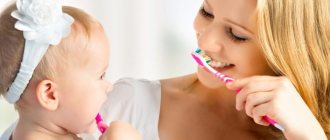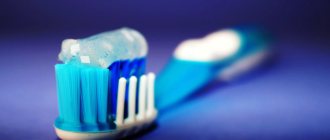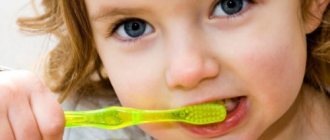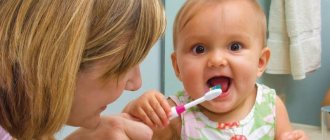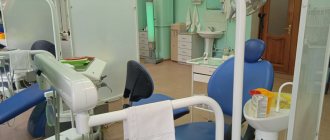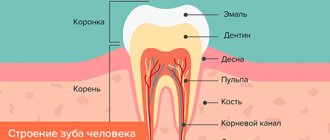The period of childhood when a child delights you with his toothless smile passes about five months after birth: at this time teething usually begins. Between the sixth and eighth months of life, the central incisors of the lower jaw begin to appear, and then the upper. By 8-12 months - lateral incisors, first on the lower and then on the upper jaw. By 12-16 months, temporary chewing teeth erupt, by 16-20 months - canines, and by 20-30 months - second chewing teeth, which complete the formation of the primary bite.
Why should you brush your baby teeth?
Many young mothers believe that brushing their baby teeth is not necessary because they will fall out anyway. However, decaying teeth
are always pain, discomfort and a source of spread of pathogenic bacteria.
How to brush your teeth correctly
How often, what to use, and in what mode is it better to brush your teeth? Detailed instructions for children and adults.
In addition, the early habit of brushing teeth becomes natural for the child and will help him preserve the health of his molars.
HOW TO BRUSH YOUR TEETH WELL?
It is important for parents not only to instill in their child the desire to keep the oral cavity clean, but also to teach him to brush his teeth correctly, properly removing plaque and food debris. To do this, you can use the following sequence of actions.
- Make movements to the right and left along the chewing surface of the lower teeth on both sides. Repeat with the top ones. The brush is held at an angle, the amplitude of its movement is short.
- Brush your front teeth up and down, then in a circular motion.
- Using sweeping movements, clean the back surfaces of the upper and lower teeth. The brush is in a horizontal position.
- In the same way, clean the teeth inside the mouth, above and below.
- The cleaning ends with a gentle massage of the gums.
Ideally, you need to repeat each movement 10 times, then move two teeth to the side. It is equally important to explain to the baby how to rinse the mouth: thoroughly, so that the water gets on all the teeth, and then spit it out (you can’t drink this liquid now).
How are the first teeth cut?
Teaching your child the rules of personal hygiene
Children are taught hygiene procedures from the first days of life. Find out how to teach your child to practice personal hygiene on his own.
The main symptoms of teething in infants are increased salivation and swelling of the gums.
The process is usually uncomfortable for the child and may be accompanied by increased moodiness and crying for no reason, insomnia and loss of appetite. A slight increase in temperature
(up to 38°C) may be a natural protective reaction of the body, but in this case the child should be shown to a doctor.
You can help the baby a little. Buy several teethers
- rubber or plastic toys for the child to bite on.
Chewing rings with liquid inside, which are first placed in the refrigerator to cool, has a particularly soothing effect. Additional methods
: Gently massage the baby's gums with a gauze pad soaked in cold water, or use baby teething gels with anesthetics, which the pediatrician will recommend.
Pediatric gingivitis
As a result of plaque accumulation, your baby may develop gingivitis. When cleaning your child's mouth, pay attention to the condition of his gums. Their redness and swelling are a sign of the onset of the disease. Another symptom is bleeding gums, which you may notice after brushing your teeth.
Regular thorough oral hygiene and professional teeth cleaning at a dental clinic can help you get rid of childhood gingivitis. If the necessary measures are not taken in time, periodontitis may develop, and then the child will require more serious treatment, including surgery.
To keep your baby's gums and teeth healthy, start regular oral care immediately after birth and be sure to take your baby to the dentist before he or she turns one.
What foods are good for your first teeth?
Foods rich in calcium
.
First of all, it is cottage cheese and hard cheese. Slightly less calcium is found in milk, fermented milk products, green leafy vegetables, gooseberries, currants, and cherries. Sources of vitamin D, without which calcium cannot be absorbed, are egg yolk and butter. You should include carbohydrate foods in your child’s diet less often: bread, potatoes, and especially sugar and sweet foods. Sweets provoke the active proliferation of bacteria in the mouth, which leads to early caries
. “The longer you don’t offer your child sweets, the better,” says Kuznetsova, “for example, children under three years old should not be given chocolate at all.”
How does caries occur?
The main causes of caries are improper oral care combined with poor diet. During the day, a plaque consisting of food debris and particles of saliva forms on the surface of the enamel. A particular danger to enamel is lactic acid, which is formed from sugars under the influence of microbes that inhabit the oral cavity.
Another cause of caries is the formation of a malocclusion. What can disrupt the formation of bite? At the age of 2 to 6 years, the following reasons are important: defective posture, mouth breathing, chewing and swallowing with an open mouth, the predominance of soft foods in the diet that do not require active chewing, the child’s habit of holding food in his cheek for a long time.
How to care for baby teeth?
From the moment the first baby teeth appear (6-8 months)
, and up to a year, parents should brush the child’s teeth with a special silicone brush placed on a finger at least once a day.
From the age of one year,
a child can brush his teeth twice a day with a very soft children's toothbrush, moving from the gums to the cutting edge or chewing surface of the teeth.
From 2-2.5 years old,
children's gel toothpaste should be used.
The amount of paste per cleaning should not exceed the size of a pea. From the age of 3,
children's teeth are brushed twice a day with a very soft toothbrush and children's toothpaste.
From the age of 2-3 years
, a child can be taught to brush his teeth independently under the mandatory supervision of his parents.
Teething
It is often difficult for parents to determine whether their baby is cutting a tooth or whether his reaction is caused by other reasons. Teething may be indicated by excessive salivation, redness of the gums, irritation of the skin around the mouth, diarrhea, and frequent awakenings at night. If your baby happily allows you to put your finger in his mouth and massage his gums, but does not allow you to look into his mouth, this is one of the signs of teething. In some children, teeth erupt evenly from month to month, while in others, sharp bursts are interspersed with pauses. Sometimes in a week 4 tubercles appear at once, indicating the imminent appearance of new teeth; in this case, you will have a particularly troublesome time.
The teething process can be disturbing and irritating for your baby. When temporary chewing teeth are cut, some babies experience very severe pain and their gums become swollen. You can relieve your baby's discomfort by using a cold compress in the shape of a dental arch. Breaking teeth make the baby want to chew on something or someone. He needs something hard to scratch his irritated gums on. During this period, teeth marks may appear on the railings of the crib, and the baby may bite and squeeze your finger and even your breast with his gums during feeding. Give your baby something cold and hard to chew on - this could be a refrigerated cookie or a special chew ring.
As for food, the situation here is different. For some children, teething does not affect their nutrition in any way, some require more food, but there are also children who refuse to eat during the teething period. The most important thing is not to panic, the baby will not remain hungry: as soon as the pain goes away, the child will make up for lost time. Try to ease your baby's suffering by using a cold spoon to feed.
Be sure to buy special “teethers” at the pharmacy (preferably with pimples and a special gel inside). Before giving them to your child, you can put them in the refrigerator for 20 minutes - the effect will be better. If a child has a high fever and it is clear that he is in pain, give him an antipyretic, but always paracetamol-based. When teething, it is also recommended to lubricate the gums with special gels. One of the most famous is “Kalgel”, although its effect lasts for a maximum of half an hour. "Solcoseryl" is more effective in this sense. However, these drugs should not be used too often: a maximum of 6 times a day, with breaks of at least 3 hours.
During the period of teething, the child especially needs special care for the oral mucosa. Biologically active components from toothpastes should help relieve inflammation and the accompanying pain symptom. They cannot be found in regular toothpastes, so the optimal choice during this period is ROX toothpastes. In particular, toothpaste “ROKS baby aroma of linden from 0 to 3 years”: in addition to the fact that it does not contain fluoride, fragrances and sodium lauryl sulfate and is safe for the child’s body when swallowed, it includes high concentrations of xylitol, which has a pronounced anti-caries effect. In addition, the paste contains linden extract, which has a mild anti-inflammatory effect, necessary for teething.
Choosing a brush and toothpaste for your baby
How to choose a toothbrush
Conventional, electric or ultrasonic? Soft or hard? Synthetic or natural? Accurate answers to all questions.
A baby toothbrush looks like this.
It has a short working part - from 18 to 25 mm. Until the age of five, a child has a brush with very soft (extra soft) synthetic bristles, and from a later age - with soft bristles with rounded ends. The handle of the children's brush is thicker, with non-slip inserts - this makes it easier for the baby to hold it. Children's toothpastes
are also different from adults. They are low in abrasives, low in fluoride, and contain fruity fragrances and flavors. Look carefully at what age of children this or that toothpaste is intended for.
When should I start using the paste?
Many moms and dads wonder when to start brushing their teeth with toothpaste. Answering it, our expert says that there are no restrictions as such in this sense. The main thing is to choose the right one according to age.
Today there are many types of pastes on the dental market. All of them are divided by age, so the samples intended for babies can be safely used from scratch. They contain no harmful substances, they are absolutely safe, and therefore can be used from the first tooth.
“Children’s toothpaste differs from adult toothpaste in its abrasiveness, or rather, its absence. Children's pastes are not abrasive, they contain less fluoride and do not have whitening properties. They are more gentle and prevent intoxication. Since children love to swallow toothpastes, there is no risk that it will have an undesirable effect,” explains the dentist.
Also, children's toothpastes, as a rule, contain aromatic additives to make the process of brushing teeth more pleasant and attractive for children. Manufacturers add different flavors to their products - strawberry, banana, apple.
You can switch to adult paste gradually, at the moment when the permanent bite of the teeth completely changes, that is, at the age of 12-13.
What parents need to remember
The baby should see the dentist for the first time at six months, and the first tooth should be cleaned with a special brush.
Sweets harm the first teeth, but daily brushing with a special children's brush and toothpaste is beneficial. Tags:
- Hygiene
- Teeth
- Preschoolers
- Babies
- Kuzmina
3 comments • To leave a comment you must be an authorized user
- few Hello everyone. I wanted to recommend a cool service to you. Using this service, you can find out for free on your phone. You can also read reviews about the numbers or leave your own if a scammer calls you. Thank you for reading my post. I create useful services for people. https://kto-zvonil.net https://kto-zvonil.net https://kto-zvonil.net https://kto-zvonil.net https://kto-zvonil.net https://kto -zvonil.net https://kto-zvonil.net https://kto-zvonil.net https://kto-zvonil.net https://kto-zvonil.net
- tancuet massage "methods: gently massage the gums"
- irina_golovleva at 6-8 months a child can be given hard cheese, gooseberries, currants, cherries???????!!!!!!!!!!!!!!!!!!!!!!!!!!! !!!
The condition of the teeth should be assessed by a specialist
Parents most often bring their child to the pediatric dentist only when there are already problems with the baby teeth. We practically don’t see healthy children whose parents want to make sure that the child’s teeth are always healthy and never hurt! For some reason, the opinion has now taken root that one cannot live without caries in life. So parents of children who already suffer from toothache and tooth decay come to us. Not all pediatricians talk about this, but parents should know that it is necessary to show the baby to the doctor at 6 months or when the first tooth emerges.
It is important to come to a specialist when there seems to be no cause for concern, because the initial stages of caries may be invisible to a layman. Caries begins when mineral substances are removed from the enamel under the influence of bacteria. As a result, a white spot forms on the surface of the tooth. It may be located in places that are inconvenient for inspection and masked by plaque, so parents may not see it or not attach any importance to it - after all, the tooth remains white.
The alarm begins to sound only when the tooth turns brown or black, a “hole” appears or the enamel chips. In this condition, the tooth requires serious and expensive treatment, which frustrates and disappoints parents.
Therefore, even if the teeth look healthy, you should visit the pediatric dentist every 2-3 months. The dentist’s experience and modern equipment make it possible to identify caries at the earliest stages and stop its development. To do this, for most children it is enough to remove plaque and treat the enamel with special means that will strengthen its structure and reduce the activity of microorganisms.
Caring for your first teeth
When your baby's first tooth erupts, it's time for dental care. Typically, silicone fingertips, a soft toothbrush, or antiseptic wipes are used for this purpose. Parents of a baby under one year old should definitely pay a visit to the Tooth Fairy, that is, the pediatric dentist. A professional will examine the baby’s oral cavity and give the necessary recommendations for care. By the age of two, a child’s primary bite is completely formed, and the number of teeth is twenty.
If at such an early age your baby tries sweets, then know that you have started a series of “dental problems”.
With the first carbohydrate “goodies”, such as cookies, buns, candies or soda, your baby gets the first dental problems - the remains of sweet food in the mouth contribute to the growth of bacteria that convert sweetness into acid, which has a detrimental effect on the teeth. At this time, the attentiveness of adults to the hygiene of the child’s dentition and oral cavity should be as high as possible.
Thus, the influence of foreign objects in the baby’s oral cavity on the occurrence of carious deposits is currently being widely studied. There are scientific opinions that pacifiers and bottles with nipples, especially at night, lead to the destruction of dental units. Therefore, pediatric dentists recommend abandoning pacifiers and pacifiers if the child is already 1.5 years old.
